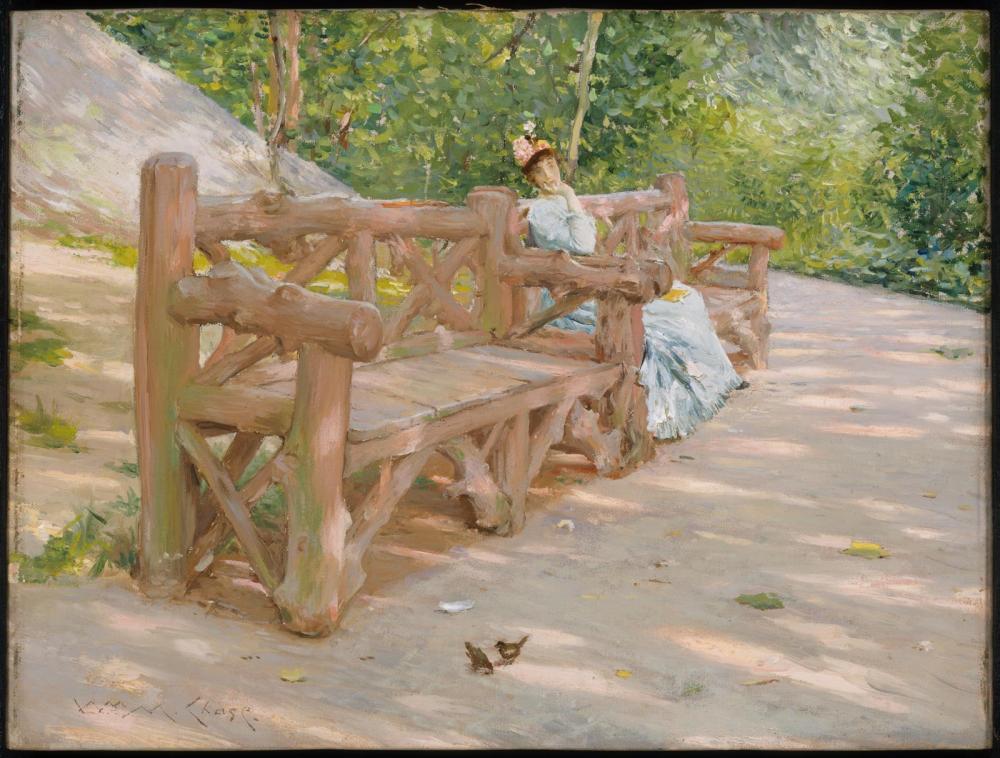Advanced Search 

Park Bench
William Merritt Chase (American, 1849–1916)
about 1890
Medium/Technique
Oil on canvas
Dimensions
30.5 x 40.6 cm (12 x 16 in.)
Credit Line
Gift of Arthur Wiesenberger
Accession Number49.1790
NOT ON VIEW
CollectionsAmericas
ClassificationsPaintings
An Indiana native, William Merritt Chase became one of the most accomplished interpreters of Impressionism in the United States. Chase first adopted a fluid painterly style in Munich, where he, like many other painters from the American Midwest (where German influence was strong), trained in the 1870s. After 1885 he shifted away from the dark figurative subjects that had earned him early recognition and began to experiment with images drawn from modern life. As did Dennis Miller Bunker [45.475] and Childe Hassam [1978.178], Chase brought together the bright colors and animated brushwork of the French style with subjects that were recognizably American. He became known for both sun-filled scenes of women and children outdoors and subtle, opalescent interiors.
Park Bench is a casual image of a woman resting in the bucolic setting of a city oasis. It was one of many pictures Chase made of urban parks in Brooklyn and Manhattan, and it is probably the painting he first exhibited in New York with the title An Idle Hour in the Park—Central Park. His audience would have been able to readily identify the rocky landscape and rusticated furniture of New York’s largest park. The preserve had been many years in the making—calls for protecting the land in the metropolis had begun in the 1830s. Twenty years later, spurred by the vanishing opportunity to create a great urban park on a par with those of London and Paris, the city bought the land and organized a competition to design it. The commission was awarded to Frederick Law Olmsted and Calvert Vaux, who developed the landscape of gentle hills, wooded glens, lakes, and submerged carriage drives still familiar today. The park was an immediate success with city residents, who enjoyed its recreational offerings in all seasons.
Chase used his series of intimate park scenes to establish himself as an innovative painter of modern subjects. He was doubtless familiar with the views of Parisian parks that had been exhibited in Paris and New York by John Singer Sargent and the Italian painter Giovanni Boldini. He also knew the urban landscapes of Hassam, including Boston Common at Twilight [31.952]. In Park Bench, Chase combined public and private worlds: his solitary model is lost in thought as if alone in one of Chase’s contemplative interiors [2007.7], but the setting is clearly outdoors and therefore shared with others. Chase’s picture captures a mere glance at an ephemeral scene: at any second, the viewer feels, either the woman will move or the observer will continue along the path. In this way, along with the quick flickering brushstrokes he used to define both the woman and the landscape, Chase brought the instantaneity of Impressionism to American shores.
This text was adapted from Elliot Bostwick Davis et al., American Painting [http://www.mfashop.com/9020398034.html], MFA Highlights (Boston: MFA Publications, 2003).
Park Bench is a casual image of a woman resting in the bucolic setting of a city oasis. It was one of many pictures Chase made of urban parks in Brooklyn and Manhattan, and it is probably the painting he first exhibited in New York with the title An Idle Hour in the Park—Central Park. His audience would have been able to readily identify the rocky landscape and rusticated furniture of New York’s largest park. The preserve had been many years in the making—calls for protecting the land in the metropolis had begun in the 1830s. Twenty years later, spurred by the vanishing opportunity to create a great urban park on a par with those of London and Paris, the city bought the land and organized a competition to design it. The commission was awarded to Frederick Law Olmsted and Calvert Vaux, who developed the landscape of gentle hills, wooded glens, lakes, and submerged carriage drives still familiar today. The park was an immediate success with city residents, who enjoyed its recreational offerings in all seasons.
Chase used his series of intimate park scenes to establish himself as an innovative painter of modern subjects. He was doubtless familiar with the views of Parisian parks that had been exhibited in Paris and New York by John Singer Sargent and the Italian painter Giovanni Boldini. He also knew the urban landscapes of Hassam, including Boston Common at Twilight [31.952]. In Park Bench, Chase combined public and private worlds: his solitary model is lost in thought as if alone in one of Chase’s contemplative interiors [2007.7], but the setting is clearly outdoors and therefore shared with others. Chase’s picture captures a mere glance at an ephemeral scene: at any second, the viewer feels, either the woman will move or the observer will continue along the path. In this way, along with the quick flickering brushstrokes he used to define both the woman and the landscape, Chase brought the instantaneity of Impressionism to American shores.
This text was adapted from Elliot Bostwick Davis et al., American Painting [http://www.mfashop.com/9020398034.html], MFA Highlights (Boston: MFA Publications, 2003).
InscriptionsLower left: Wm M. Chase.
ProvenanceAfter 1890, probably Annie DeCamp Hegeman (Mrs. Henry Kirke) Porter (1836-1925), Pittsburgh, Penn., who was a friend of the artist; about 1925, by descent to her daughter, Miss Annie May Hegeman (1859-1948), Lenox, Mass.; October 15-16, 1942, Hegeman and others sale, Parke-Bernet Galleries, New York, lot 317, as "The Park" to Arthur Weisenberger; 1949, gift of Arthur Weisenberger to the MFA. (Accession Date: December 8, 1949)
